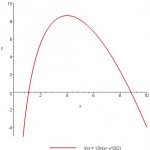red and white kop!
Junior Member
- Joined
- Jun 15, 2009
- Messages
- 231
the function f is defined for positive real values of x by f(x)=12lnx - x^(3/2)
the curve crosses the x-axis at points A and B
a. by calculation, show that the value of x at point A lies between 1.1 and 1.2
b. the value of x at the point B lies in the interval (n, n+1) where n is an integer. find n
for a. i took 12lnx = x^(3/2) and turned it all around, getting e^x^(3/2) = x^12 etc. but i still have no idea of how to get the interval for x
for b. i have no idea
the curve crosses the x-axis at points A and B
a. by calculation, show that the value of x at point A lies between 1.1 and 1.2
b. the value of x at the point B lies in the interval (n, n+1) where n is an integer. find n
for a. i took 12lnx = x^(3/2) and turned it all around, getting e^x^(3/2) = x^12 etc. but i still have no idea of how to get the interval for x
for b. i have no idea

